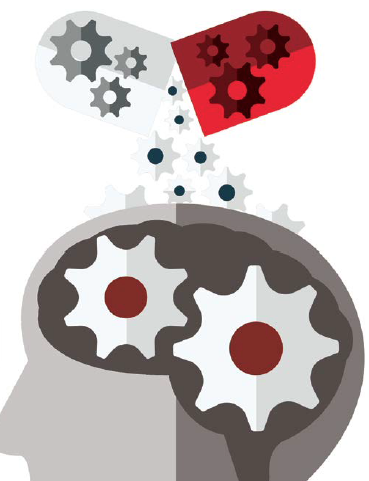 The three-pound organ — made up of more than 100 billion nerves — that serves as the center of the nervous system is one of the most complex parts of the human body. Only recently have researchers and scientists begun to understand the brain and what can go wrong.
The three-pound organ — made up of more than 100 billion nerves — that serves as the center of the nervous system is one of the most complex parts of the human body. Only recently have researchers and scientists begun to understand the brain and what can go wrong.
This special forum kicks off a year-long look at the brain and the CNS market. Each month, we will examine a specific aspect of this therapeutic category, starting this month with a general overview. Next month, we’ll provide an update on Alzheimer’s research. In subsequent months, we will tackle a variety of CNS-specific topics, including: psychiatric research trends, patient care, early detection, clinical research organizations, specialty patient audience, and marketing.
Scientists have learned more about the brain in the last 10 years than in the last century. The sequencing of the human genome, the development of new tools for mapping neuron connections, and new imaging technologies have yielded many insights.
But despite the many advances in neuroscience in recent years, the human brain remains one of the greatest mysteries, and many causes of neurological disorders are not fully known.
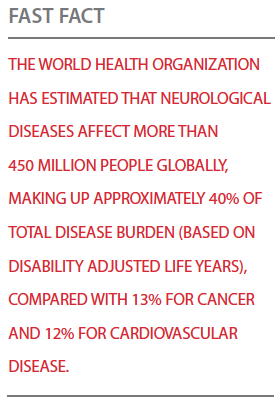 What we do know is that brain disorders, including developmental, psychiatric, and neurodegenerative diseases, represent an enormous disease burden. Brain-related illnesses afflict more than 2 billion people worldwide. PwC estimates that the medical treatment costs and long-term care costs related to brain disease in the United States were about $500 billion in 2012. If other nonmedical costs are included and were similar to those in other studies, the total would be over $900 billion annually. Alzheimer’s alone costs the U.S. system $172 billion a year. In the United States and European Union the economic burden of CNS diseases — including direct medical costs, direct nonmedical costs, and costs of informal (family) care — is estimated at more than $2 trillion, a number expected to triple to $6 trillion by 2030.
What we do know is that brain disorders, including developmental, psychiatric, and neurodegenerative diseases, represent an enormous disease burden. Brain-related illnesses afflict more than 2 billion people worldwide. PwC estimates that the medical treatment costs and long-term care costs related to brain disease in the United States were about $500 billion in 2012. If other nonmedical costs are included and were similar to those in other studies, the total would be over $900 billion annually. Alzheimer’s alone costs the U.S. system $172 billion a year. In the United States and European Union the economic burden of CNS diseases — including direct medical costs, direct nonmedical costs, and costs of informal (family) care — is estimated at more than $2 trillion, a number expected to triple to $6 trillion by 2030.
Neurological disorders consist of more than 600 conditions, impacting an estimated 50 million Americans every year. Some of the major types of disorders include: neurogenetic diseases (such as Huntington’s disease and muscular dystrophy), developmental disorders (such as cerebral palsy), degenerative diseases (such as Parkinson’s disease and Alzheimer’s disease), metabolic diseases (such as Gaucher’s disease), cerebrovascular diseases (such as stroke and vascular dementia), trauma (such as spinal cord and head injury), convulsive disorders (such as epilepsy), infectious diseases (such as AIDS dementia), and brain tumors.
Scientists around the globe are collaborating to find new or more effective treatments for patients with these complex disorders, but R&D in this area is risky. Numerous trials for Alzheimer’s disease, major depression, stroke, and schizophrenia have failed. In fact the overall clinical approval success rate — share of compounds entering clinical testing that obtain marketing approval — for CNS compounds first tested in human subjects from 1995 to 2007 (and followed through 2013) was 6.2%, or less than half the 13.3% rate for non-CNS drugs, according to the Tufts Center for the Study of Drug Development.
To accelerate research in this area, in 2014, President Obama launched the Brain Research through Advancing Innovative Neurotechnologies (BRAIN) Initiative. Recently the National Institutes of Health announced its second wave of grants to support the goals of the initiative, bringing the NIH investment to $85 million in fiscal year 2015. These awards expand NIH’s efforts to develop new tools and technologies to understand neural circuit function and capture a dynamic view of the brain in action. Projects include proposals to develop soft self-driving electrodes, ultrasound methods for measuring brain activity, and the use of deep brain stimulation to treat traumatic brain injuries.
CNS Research
Research in the CNS area has been cyclical. There were key failures of drugs about five to 10 years ago, experts say, and this led to a decline in research.
But now there is an upward trend in research of the brain. Experts say CNS is now a vibrant space with increased research spending in neurodegenerative diseases, such as Alzheimer’s and Parkinson’s, and in neurodevelopment disorders such as ADHD and autism. America’s biopharmaceutical research companies are currently developing 420 medicines for patients suffering from neurological disorders, including epilepsy, Alzheimer’s disease, multiple sclerosis, and Parkinson’s disease, according to a report from the Pharmaceutical Research and Manufacturers of America (PhRMA) and the Epilepsy Foundation.
“This upward trend is going to continue for a while," says Thomas Zoda, Ph.D., executive VP and general manager of INC Research’s CNS clinical development. “There is a significant amount of research and there will continue to be a tremendous amount of research in the dementia space. There continues to be unmet needs across a number of psychiatric indications, in depression and schizophrenia."
When more targets have been identified for neurodegenerative diseases, there will be an upsurge of clinical pipelines and an increase in the number of studies, says Johan den Boer, M.D., Ph.D., director of science and professor of psychopharmacology and neuroscience early development services, PRA Health Sciences.
 “The biggest challenge will be to find a drug that will delay the onset of Alzheimer’s disease, Parkinson’s disease, and other neurodegenerative disorders," he says. “In Parkinson’s disease, preclinical studies have highlighted many new non-dopaminergic strategies including drugs targeting adenosine, glutamate, adrenergic, serotonin receptors, as well as calcium channel-blockers, ironchelators, anti-inflammatories, neurotrophic factors. In spite of the fact that dopaminergic strategies are the mainstay of therapy, there is a clear unmet need to develop targets that are more closely related to the underlying pathology."
“The biggest challenge will be to find a drug that will delay the onset of Alzheimer’s disease, Parkinson’s disease, and other neurodegenerative disorders," he says. “In Parkinson’s disease, preclinical studies have highlighted many new non-dopaminergic strategies including drugs targeting adenosine, glutamate, adrenergic, serotonin receptors, as well as calcium channel-blockers, ironchelators, anti-inflammatories, neurotrophic factors. In spite of the fact that dopaminergic strategies are the mainstay of therapy, there is a clear unmet need to develop targets that are more closely related to the underlying pathology."
The avenues for researching CNS diseases have increased quite a bit, says Amar Thyagarajan, Ph.D., senior product manager, Taconic Biosciences.
“We have a lot more understanding around the mechanisms of the brain today than we did 10 years ago," he says. “Technologies and genetic engineering technologies to create the appropriate models have advanced to allow for the development of various biologics against these diseases."
One company that had exited the CNS area and is now once again researching new therapies for the brain is Novartis.
“Novartis’ predecessor companies Ciba and Sandoz had been very successful in neuroscience for a long time," says Ricardo Dolmetsch, global head of neuroscience at Novartis Institutes for BioMedical Research. “In the late 1990s or early 2000s, there was a change in strategy throughout the industry toward disease-modifying therapies, but we didn’t understand the targets. In the past, neuroscience medicines were not well-validated in humans, so therefore most of those candidates didn’t work very well."
There are now huge cohorts of patients with neurological and psychiatric disease, Mr. Dolmetsch says.
“We can sequence DNA, identify mutations, and we know that at least in some cases, mutations caused their disease," he says. “That allows us to tie drug development to humans in a way that was difficult before."
Mr. Dolmetsch says the sequencing of genomes has been transformative in the exploration of neuroscience.
“We didn’t have brain biopsies, therefore we had no way of testing compounds or antibodies on human cells," he says. “Now that we have the capacity to take blood or skin cells and convert them into stem cells and then make them into neurons, we can use them as a way of optimizing molecules. We think this process will be transformative."
Additionally, there has been increased understanding of the brain circuitry.
“Historically, in psychiatry especially, we thought of circuitry in a very coarse way," Mr. Dolmetsch says. “We thought of modulating the levels of a neurotransmitter as if the brain was a giant bowl of soup, so we would just add a little bit more dopamine, a little bit more serotonin, and see what happens. These were very coarse manipulations."
In Alzheimer’s disease, Novartis is conducting trials of preventive medications. The two treatments under investigation target the amyloid cascade.
One targets a molecular machine in the brain called BACE-1. Part of this machine acts as scissors that cut up neuronal membrane proteins for disposal. This snipping process creates amyloid fragments, some of which might cause Alzheimer’s. The Novartis treatment is designed to jam up the scissors to reduce and possibly eliminate the formation of amyloid.
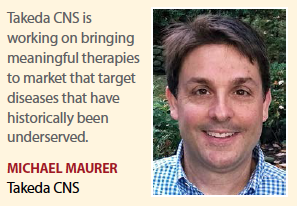 The other experimental treatment to be tested in the trial is an active immunotherapy drug. A small, harmless segment of the toxic amyloid protein is injected into the body. The immune system then responds by producing antibodies that recognize the amyloid protein and act to clear it. The team found in a Phase II trial that as the immune system responds to the treatment, the burden of brain amyloid decreases.
The other experimental treatment to be tested in the trial is an active immunotherapy drug. A small, harmless segment of the toxic amyloid protein is injected into the body. The immune system then responds by producing antibodies that recognize the amyloid protein and act to clear it. The team found in a Phase II trial that as the immune system responds to the treatment, the burden of brain amyloid decreases.
“All the genetic evidence suggests that amyloid cascade is something that happens many years before people start having symptoms of the disease," Mr. Dolmetsch says. “We’re testing this in a collaboration with the Banner Institute in people who we think have a very high chance of getting AD because they have two copies of the APOE-e4 gene."
Researchers will study how much plaque patients have at the beginning and end of the trial and see who gets Alzheimer’s.
“The genetics suggests that if we can intervene early, then the treatment would probably work," Mr. Dolmetsch says. “We hope that even if the trial doesn’t work, we will be able to identify prognostic markers, so we can evaluate whether people are getting better or worse."
Mr. Dolmetsch says Novartis also has a number of early-stage projects. One example is a trailblazing project studying spinal muscular atrophy, a devastating childhood disease that is associated with degeneration of motor neurons, which is caused by a mutation in a gene called the SMN1 gene. The company has developed a drug that can rescue the stem cells that have a defect.
 Dr. den Boer agrees over the past several years there has been enormous progress in genetics, molecular biology, neuroplasticity research, imaging techniques and brain-machine interface devices, but there is still a long way to go transform CNS drug development.
Dr. den Boer agrees over the past several years there has been enormous progress in genetics, molecular biology, neuroplasticity research, imaging techniques and brain-machine interface devices, but there is still a long way to go transform CNS drug development.
“Many new CNS targets have been identified, but progress in drug development has been hampered by failing predictive value from animal experiments, lack of effects due to high placebo responses in pain and psychiatric patients, and sometimes poor brain penetration," he says. “In addition, patient heterogeneity has contributed to negative drug trials, for example, in Alzheimer’s disease and pain."
For psychiatric disorders, Dr. den Boer says many genes associated within a wide range of psychiatric disorders have been identified that are all located on different chromosomes. Recent meta-analysis revealed that many genetic variants are shared in common between two or more disorders.
Other analysis found genome-wide association studies of the same disorders in which hardly any overlap was present in genetic variants.
“We are still a long way from identifying which pattern of genes may confer specific risks for the development of emotional or cognitive problems, but in the coming decade it is foreseeable that specific genetic signatures may emerge, for example schizophrenia, bipolar disorder, neurodegenerative diseases, and chronic pain," Dr. den Boer says. “Ultimately, these genetic discoveries will provide clues to the molecular processes involved in the development of mental disorders, leading to specific, biotechnology-driven and disease-modifying personalized pharmacotherapeutics."
Jeffrey Jonas, M.D., CEO of Sage Therapeutics, says interest in the CNS space will continue to increase.
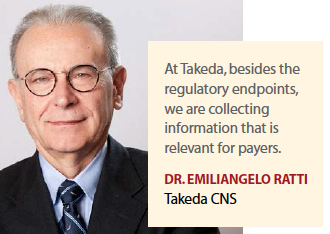 “This cycle is just beginning as researchers are pursuing novel mechanisms and innovative approaches to helping patients with CNS disorders," he says. “The challenge with CNS disorders is that the brain does not function like a tumor. In cancer, we can find a mutation or identify a genetic signature that has an impact that is directly translatable into the pathology being treated. In CNS disorders, the lesion that initiates the disorder may have occurred years before and may be unrelated downstream to the symptoms that are actually troubling the patient that require treatment. This makes CNS drug development trickier and less linear."
“This cycle is just beginning as researchers are pursuing novel mechanisms and innovative approaches to helping patients with CNS disorders," he says. “The challenge with CNS disorders is that the brain does not function like a tumor. In cancer, we can find a mutation or identify a genetic signature that has an impact that is directly translatable into the pathology being treated. In CNS disorders, the lesion that initiates the disorder may have occurred years before and may be unrelated downstream to the symptoms that are actually troubling the patient that require treatment. This makes CNS drug development trickier and less linear."
Sage’s approach to CNS development focuses on two critical nervous system receptor families: GABAA receptors and NMDA receptors. Imbalances in GABAA and NMDA receptor activity have been implicated in a broad spectrum of disorders, including disorders of mood, seizure, cognition, anxiety, sleep, pain, epilepsy, and movement.
The company’s lead product, SAGE-547, achieved a 77% response rate in evaluable patients with super-refractory status epilepticus (SRSE), in a successfully completed Phase I/II clinical trial. The product is in Phase III trials.
A Long Road to Market
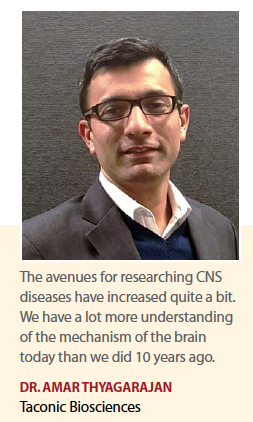 Drugs that treat CNS diseases take more than a year longer to develop and are less than half as likely to obtain marketing approval than other drugs, according to a 2014 study by the Tufts Center for the Study of Drug Development. Mean clinical development time for CNS drugs approved for marketing in the United States was 12.8 months, or 18%, longer than for non-CNS compounds.
Drugs that treat CNS diseases take more than a year longer to develop and are less than half as likely to obtain marketing approval than other drugs, according to a 2014 study by the Tufts Center for the Study of Drug Development. Mean clinical development time for CNS drugs approved for marketing in the United States was 12.8 months, or 18%, longer than for non-CNS compounds.
One bright statistic: despite longer clinical and approval phase times, and lower clinical success rates, CNS approvals have held steady, accounting for about one in 10 of all U.S. approvals since the 1980s.
Dr. Zoda points out that each of the subcategories of CNS — analgesia, neurology, and psychiatry — is distinct and has its own challenges.
“Analgesia indications are dependent upon the patients’ perception of pain and how well they are being treated," he says. “Neurology outcomes are a little more objective. Psychiatry is more difficult and is dominated by subjective rating scales, which are mostly dependent on the investigators’ ability to do structured interviews with patients."
Additionally, Dr. Zoda says CNS trials are not simple trials.
“For example, multiple sclerosis or Alzheimer’s disease trials are quite long and expensive," he says. “Counting the amount of treatment time and the number of patients who are needed and time it takes to enroll those patients, a trial can run three, four, or five years. This is a huge outlay of time and expense and not every company is willing to do this."
To help speed the process companies rely on translational research, with a good animal model with predictive validity, experts say.
“The better the preclinical model, the more likely it is that there is going to be a drug that actually works in humans," Mr. Dolmetsch says. “It’s possible to significantly de-risk the project if there is a human or animal model that reflects the underlying pathophysiology of the disease."
But animal models are not always predictive in CNS.
“The translation from animal model to human in CNS trials is still very ill defined," Mr. Dolmetsch says. “The process is not quite as cut and dried as in some metabolic diseases."
Dr. Thyagarajan agrees having the appropriate animal models is a challenge in CNS research.
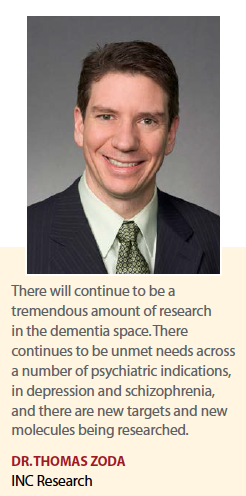 “Some of the animal models are quite good," he says. “But that said, a mouse that has been engineered with a human component is still a mouse; it still has other mouse parts in it, both at the genomic level and the physiologic level."
“Some of the animal models are quite good," he says. “But that said, a mouse that has been engineered with a human component is still a mouse; it still has other mouse parts in it, both at the genomic level and the physiologic level."
Dr. Jonas says to make progress, companies need to be more agnostic about translational models, especially in CNS disorders where the pathophysiology and phenomenology are very complicated and disorders are polygenic.
“Research needs to be more practical and look at on-target effect and more assertive in developing programs to get drugs into patients to evaluate if there’s evidence of human activity," he says. “We also need to continue to develop endpoints that reflect clinical benefit, not mechanistic target acquisition."
In the development of mental disorders, however, environmental factors may play a decisive role in converting a vulnerability factor into a biological mechanism that causes changes in the brain and the subsequent development of psychopathology, Dr. den Boer says. Thus, he suggests companies should abandon the idea that psychiatric syndromes, such as major depression or obsessive compulsive disorder can be modeled in a rodent.
“These translational problems are not specific to CNS disorders but to all chronic diseases and diseases with a multifactorial pathogenesis," he says. “All features of a disease can hardly be modeled using a single animal model. Animal models are able to address certain aspects of the disease process, for instance the disease expression with organ/tissue damage.
“Some of the problems are technical in the sense that with some experimental compounds we simply do not know how they enter the brain, and if they do what systemic changes they might induce," Dr. den Boer says. “Thus, many clinicians argue that a wide gap exists between academic researchers who employ fancy molecular biological techniques and experimental animal models, and the clinical reality of everyday life in which patients still simply use psychotropic medication that was invented three decades ago."
The High Risk and High Return of CNS Commercialization
New business strategies for CNS are being developed as the industry faces increasing pressure to cut spending, to fully understand brain disease faster, and to share risk of development with industry partners. Over the past few years, large pharmaceutical companies have downsized their neuroscience research divisions, due to the difficulties of developing drugs to treat brain diseases, including being more time-consuming and expensive than developing drugs for other therapeutic areas. The high risk and low approval rates of drugs targeting diseases such as Alzheimer’s, Parkinson’s, depression, anxiety, schizophrenia, and stroke have cost the industry billions of dollars in recent years.
However, there are still manufacturers in the game, focusing on more targeted areas, and partnering with others to help share the burden of risk.
Take Takeda CNS for example. The Takeda growing portfolio of marketed CNS products includes one co-marketed drug in the United States with Lundbeck, another drug marketed in Switzerland through a partnership with Dainippon-Sumitomo, and one medication co-marketed in Japan with Janssen.
Takeda also has a late clinical-stage program for Alzheimer’s disease prevention with Zinfandel Pharmaceuticals.
“Historically, big pharmaceutical companies have exited or shied away from the CNS therapeutic area, but recently there is a renewed interest not only by biotechnology companies but also the traditional pharmaceutical players," says Michael Maurer, therapeutic area commercial leader, specialist medicines, Takeda CNS. “This is a really interesting and exciting time for the industry in terms of CNS, as well as for patients and clinicians."
In addition, Takeda has engineered its development strategy in CNS to include a stronger focus on the payer market, and the probability of adequate reimbursement in an effort to enhance its go no-go decision making.
Takeda CNS is also focusing away from the broader CNS diseases to focus on innovative therapies for underserved populations.
“We are working on bringing some meaningful therapies to market that target diseases that have historically been underserved, “ Mr. Maurer says.
While it’s the science that drives this focus, a huge factor in a successful market launch depends on reimbursement. This presents a new challenge that has increasingly become more important with healthcare reform measures. Getting FDA approval is no longer the single biggest hurdle; creating a drug that will be reimbursed by payers is.
“Today, the real acceptance of the value of a new medicine will be determined by the people who have to pay," says Emiliangelo Ratti, M.D., head of CNS therapeutic area unit, Takeda CNS.
By focusing on special populations for which there is very clear medical need, Takeda CNS expects to be able to illustrate the positive impact of a therapy, such as significant improvement in the patient’s quality of life, reduction in hospitalization rates, and the social economic benefit of managing disease.
For example, its development program has been designed to capture not only the information that the FDA requires for approval, but also data that would be useful for the payer.
“Besides the regulatory endpoints, we are collecting information from the beginning of the process that is relevant for payers," Dr. Ratti says. “These data include the outcome endpoints that present a tangible example that a particular drug can improve not only the quality of life of the patient, but can also save money."
Takeda CNS will also be using digital technology in clinical trials to collect patient outcomes in real time to better access the effectiveness of what a novel drug can do in the management of the key symptoms of a given disease.
“By applying these new, very innovative technologies, we will be able actually to provide much more relevant data that can constitute a much more convincing argument for reimbursement," Dr. Ratti says.
This new mindset will require that R&D and commercial teams work together to bring the drug to market. At Takeda CNS, that shift has occurred, with the R&D teams involved in providing information that will help differentiate the drug and gain payer support.
Dr. Ratti and his team focus both on the science of the medicine, as well as on its commercial attributes.
“If we can create a drug that is generously reimbursed by payers, as an R&D person, you can say you have done your job," he says. “This mindset starts directly in R&D, where we also consider what will be eventually reimbursed by the payer."
Mr. Maurer says this is a new way of thinking in the industry, and he expects there will be much more collaboration between the R&D, commercial, and market access teams.
“At Takeda, we embody this approach, and I expect to see many more teams across the industry getting into closer partnerships, so no one is operating in isolation."
Another shift in the commercialization process is engaging consumers — especially payer groups — much earlier in the process than before, Mr. Maurer says.
“We should be involving payers as early as Phase I," he says. “Historically, the industry has waited until Phase III to have discussions with payers, and that is too late."
“Takeda is dedicating a significant amount of resources and investment in functions to understand the key drivers that can generate value in a novel medicine," Dr. Ratti adds.
“We have a very important department of global outcome research that is really trying to identify which are the functional outcomes of a given study that can really save money to the management of a given disease," he continues. “We also have the market access department that has constant connections with the payers and the various authorities in different areas."
Experts agree that the discussion with payers has also changed, and has become more of a consultative process throughout the stages, as opposed to just presenting the clinical data available at launch. (PV)


















